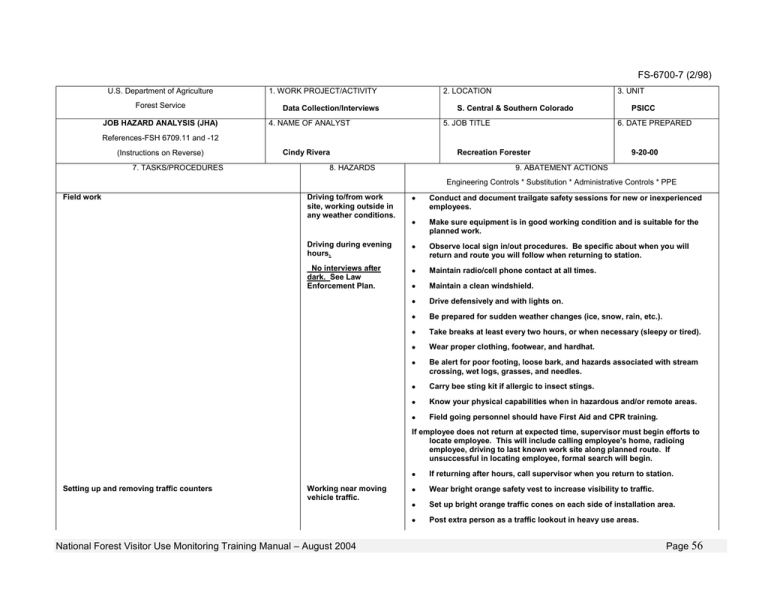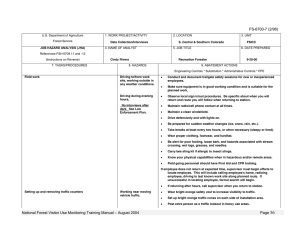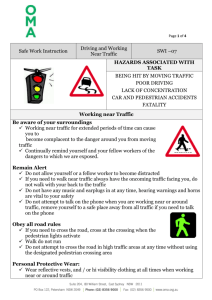FS-6700-7 (2/98)
advertisement

FS-6700-7 (2/98) U.S. Department of Agriculture Forest Service JOB HAZARD ANALYSIS (JHA) 1. WORK PROJECT/ACTIVITY 2. LOCATION Data Collection/Interviews 3. UNIT S. Central & Southern Colorado 4. NAME OF ANALYST 5. JOB TITLE PSICC 6. DATE PREPARED References-FSH 6709.11 and -12 (Instructions on Reverse) 7. TASKS/PROCEDURES Cindy Rivera Recreation Forester 8. HAZARDS 9-20-00 9. ABATEMENT ACTIONS Engineering Controls * Substitution * Administrative Controls * PPE Field work Driving to/from work site, working outside in any weather conditions. Conduct and document trailgate safety sessions for new or inexperienced employees. Make sure equipment is in good working condition and is suitable for the planned work. Driving during evening hours. Observe local sign in/out procedures. Be specific about when you will return and route you will follow when returning to station. No interviews after dark. See Law Enforcement Plan. Maintain radio/cell phone contact at all times. Maintain a clean windshield. Drive defensively and with lights on. Be prepared for sudden weather changes (ice, snow, rain, etc.). Take breaks at least every two hours, or when necessary (sleepy or tired). Wear proper clothing, footwear, and hardhat. Be alert for poor footing, loose bark, and hazards associated with stream crossing, wet logs, grasses, and needles. Carry bee sting kit if allergic to insect stings. Know your physical capabilities when in hazardous and/or remote areas. Field going personnel should have First Aid and CPR training. If employee does not return at expected time, supervisor must begin efforts to locate employee. This will include calling employee's home, radioing employee, driving to last known work site along planned route. If unsuccessful in locating employee, formal search will begin. Setting up and removing traffic counters Working near moving vehicle traffic. National Forest Visitor Use Monitoring Training Manual – August 2004 If returning after hours, call supervisor when you return to station. Wear bright orange safety vest to increase visibility to traffic. Set up bright orange traffic cones on each side of installation area. Post extra person as a traffic lookout in heavy use areas. Page 56 Pulling moving traffic to interview location The interview Flying gravel from moving vehicles. Wear safety glasses while installing/removing traffic counters. Working near moving vehicle traffic. Post 2 traffic signs at least 150 feet BEFORE the traffic pull-off site. One should read "STOP AHEAD" and the other should read "VOLUNTARY RECREATION USE SURVEY AHEAD". Place at least 4 traffic cones near interview point. One before the pull-off, 1 after the pull-off, and 2 between where the recreation vehicle will stop and the flow of ongoing traffic. Wear bright orange safety vest at all times when flagging vehicles over. Do not force vehicles to stop. If someone is not slowing down, do not attempt to stop them for an interview. When a vehicle is pulling into the pull-off or exiting the pull-off, stand well back from the vehicle (Beware, sometimes trailers are wider than the vehicle pulling them). Have the vehicle pull well off the roadway, as far from the traffic flow as practical. If the visitor does not want to participate in the interview, do not delay letting them leave. At anytime during the interview process, if employee feels threatened or uncomfortable, excuse yourself from visitor and walk to your own vehicle. Immediately call for help on radio or cell phone. If suspicious persons are stopped, allow them to leave. Take vehicle license number and direction of travel if possible. Wear comfortable shoes. Wear appropriate clothing for weather conditions, taking in to account the inactivity of standing. Drink plenty of water, at least 2 quarts per day. Eat healthful food. Take a break for at least 15 minutes every 2 hours. Walk around. Stretch legs, back, arms, and hands. Sit during breaks. During lightening storms return to vehicle and wait until all danger has passed before continuing interviews. Be extra careful during rain, fog, or snow conditions. Use 2 people for traffic stops and wear bright, visible rain gear. use emergency flashers. Dangerous or uncooperative visitor. Standing all day in any type of weather. 10. LINE OFFICER SIGNATURE /s/ Bill Wood National Forest Visitor Use Monitoring Training Manual – August 2004 11. TITLE Deputy Forest Supervisor 12. DATE 9/20/00 Page 57





